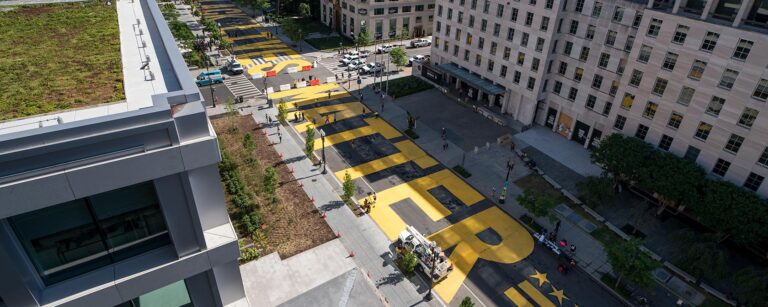Washington DC’s Black Lives Matter Plaza Removal: A Turning Point in Urban Memory and Racial Justice
Black Lives Matter Plaza’s Demolition: A Catalyst for National Reflection
In a move that has reverberated across the country, Washington DC’s Black Lives Matter Plaza—an emblematic site born out of the 2020 racial justice protests—has been dismantled. This plaza, renowned for its bold street murals and as a public testament to the fight against systemic racism and police brutality, stood as a powerful urban landmark. Its removal has ignited widespread debate about how societies commemorate social movements and the durability of such symbols in public spaces.
Proponents of the plaza viewed it as a vital acknowledgment of ongoing racial equity struggles, while detractors argue that its demolition risks erasing an important chapter of American history. City officials have cited practical concerns such as maintenance and urban redevelopment as primary motivations for the change, promising a redesigned space that aims to be more inclusive. Meanwhile, activists and community members express apprehension that this action could undermine the momentum of racial justice advocacy.
| Stakeholder | Core Arguments |
|---|---|
| Municipal Authorities | Focus on safety improvements, infrastructure upgrades, and inclusive urban design |
| Activists & Community Advocates | Emphasize the plaza’s historical importance and fear cultural erasure |
| General Public | Mixed reactions; calls for open dialogue and alternative commemorations |
- Nationwide ripple effect: Other cities are reexamining how they honor activist movements in public spaces.
- Media spotlight: Heightened scrutiny on governmental stewardship of culturally significant landmarks.
- Future considerations: Growing advocacy for community-inclusive planning in urban redevelopment projects.
Community Response and Activism: Beyond the Physical Space
The plaza’s removal has deeply affected Washington DC’s activist circles and residents, many of whom regarded the site as a tangible voice for justice and reform. Far from dampening the movement, this event has galvanized renewed efforts to sustain racial equality campaigns through diverse channels. Grassroots organizations have amplified their presence via social media outreach, educational workshops, and coalition-building to ensure the message transcends physical landmarks.
Community leaders warn that without deliberate preservation, the erasure of such spaces risks diminishing public awareness of critical social narratives. In response, activists have adopted multifaceted strategies to maintain visibility and influence:
| Focus Area | Initiatives | Anticipated Impact |
|---|---|---|
| Educational Outreach | Hosting public talks, creating new murals, and storytelling events | Enhance cultural memory and community engagement |
| Digital Advocacy | Launching hashtag campaigns and virtual discussion forums | Expand awareness beyond local communities |
| Mobilization Efforts | Coordinating protests and forming alliances with allied groups | Sustain pressure for legislative and social reforms |
| Policy Engagement | Lobbying for inclusion of racial justice priorities in city planning | Institutionalize equity-focused urban policies |
- Heightened visibility of activism despite loss of physical landmark
- Commitment to narrative preservation as a tool for empowerment and education
- Strategic focus on embedding social justice in policy and culture
Urban Redevelopment Drives Plaza’s Removal: City’s Vision for the Future
Local government officials attribute the plaza’s dismantling to broader urban renewal initiatives aimed at modernizing downtown Washington DC. The redevelopment plan prioritizes enhanced infrastructure, improved pedestrian pathways, and expanded public transit options to meet the demands of a growing urban population. These upgrades are intended to stimulate economic vitality while creating a safer, more accessible environment for residents and visitors alike.
Key components of the redevelopment include:
- Modernizing roadways to improve traffic efficiency and integrate future transit systems.
- Enhancing public safety through better lighting and emergency access improvements.
- Introducing new green spaces designed for sustainability and community recreation.
| Project Element | Expected Completion Year |
|---|---|
| Pedestrian-Friendly Streetscape | 2025 |
| Expanded Public Transit Infrastructure | 2026 |
| Green Space Development | 2024 |
Preserving Protest Art and Historical Narratives: A Growing Movement
In the wake of the plaza’s removal, cultural advocates and historians have intensified calls to safeguard the protest art and historical significance embedded in such spaces. These murals and installations are not merely artistic expressions but serve as enduring records of social resistance and collective memory. Without proactive preservation, there is a risk that these visual testimonies to racial justice struggles will be lost to time.
Preservation advocates emphasize several urgent actions:
- Comprehensive documentation and digital archiving of existing protest artworks.
- Official designation of sites like Black Lives Matter Plaza as protected cultural landmarks.
- Allocation of funds dedicated to conserving street art and related installations.
- Collaborative efforts between municipal authorities, artists, and grassroots groups to develop sustainable preservation strategies.
| Group | Preservation Role | Current Initiatives |
|---|---|---|
| Local Artists | Creators and stewards of cultural heritage | Campaigning for archival projects and public awareness |
| Historians | Chroniclers of social movements | Researching and documenting visual protest narratives |
| City Officials | Regulatory oversight and landmark designation | Assessing potential for protected status |
| Community Organizations | Mobilizing public support and advocacy | Organizing preservation campaigns and educational programs |
Conclusion: The Enduring Legacy of Black Lives Matter Plaza
The dismantling of Black Lives Matter Plaza in Washington DC represents a pivotal moment in the ongoing conversation about how public spaces reflect and shape social justice movements. While the physical site may no longer exist, its symbolic power endures, reminding us of the profound impact grassroots activism has on urban landscapes and national consciousness. As the city embarks on redevelopment, the challenge remains to honor this legacy through inclusive planning and committed preservation efforts. Future updates will monitor how stakeholders navigate this complex intersection of memory, activism, and urban progress.







